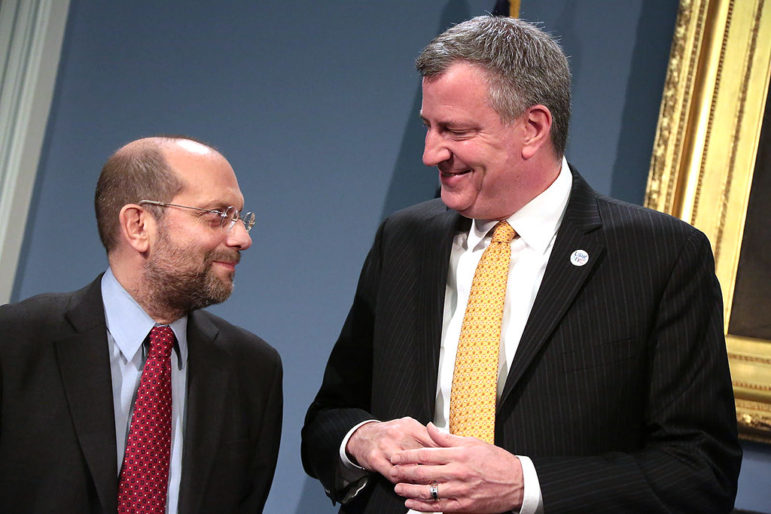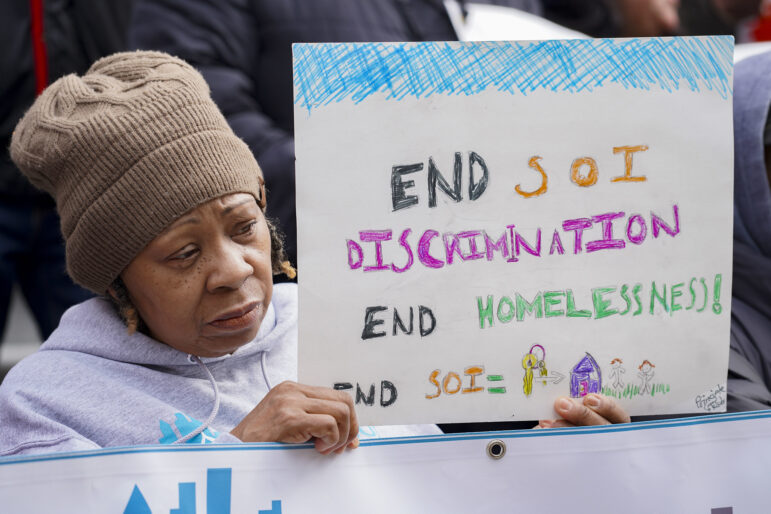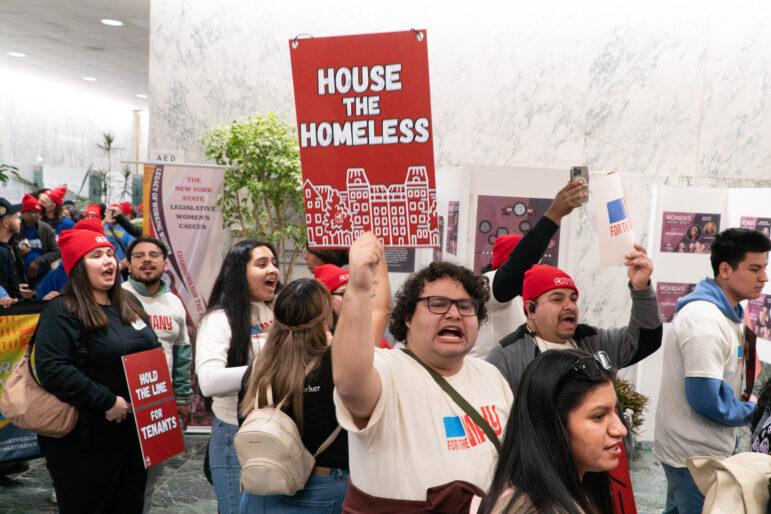
Ed Reed for the Office of Mayor Bill de Blasio
Mayor de Blasio introduces Steven Banks as commissioner of the Department of Social Services in early 2014.
The de Blasio administration has “been able to break the trajectory of homelessness by reducing the growth of family homelessness,” the mayor’s social services chief told the Max & Murphy Show on Wednesday.
“For the first time in a decade, the DHS shelter census is flat and actually trending downward, after years of exponential increase, particularly those years 2011-2014,” Steven Banks, the commissioner of the Department of Social Services, which oversees the Department of Homeless Services and the Human Resources Administration, told the WBAI program (which you can hear below). “So simply breaking the trajectory and beginning to move in a downward direction has been a result of having for the first time a comprehensive plan.”
As of Tuesday, just under 60,000 people were in the city’s shelter system, including more than 21,000 children. That’s far larger than the population served in the autumn of 2011, when 41,000 people slept on city beds. But Banks is right that the rate of growth has slowed dramatically. The homeless-shelter census grew 18 percent from September 2013 through September 2016, but only 1.6 percent since then, with the last year seeing a slight decline.
Banks attributed that to a mix of city policies.
And we’ve seen a more than a third decrease in evictions. Let me just repeat that. Nearly a third decrease in evictions by city marshals, and that’s even before the historic rent law reforms that just occurred. So while evictions are going up across the country, evictions are actually down in New York City. In addition to providing lawyers in court, we’ve driven up the representation rate from 1 percent, 1 out of 100 tenants had a lawyer, now partially through the five year implementation, about 30 percent of the tenants have got lawyers, and that’s really a tremendous change in leveling the playing field in fairness.
Banks said vouchers for permanent housing had moved 120,000 people out of shelters. He also credited the merger of DHS and HRA, which lowered barriers to getting rent-arrears payments to people facing evictions. Meanwhile, under the mayor’s 2017 “Turning the Tide Plan,” Banks said DHS had succeeded in closing 200 of the 360 places where the city either used hotels or private apartments (a.k.a. cluster sites) to handle shelter volume. And of the 90 new shelters the de Blasio plan promised, 48 have been sited, some’—but, as Banks made a point of noting, not all’—facing stiff community opposition.
The overall change in the shelter census masks dynamic changes within the homeless population. While just shy of two thirds of shelter residents are in families with children, the number of families with kids has actually shrunk over the past four years. The number of single adults in the system, however, has soared 63 percent since de Blasio became mayor. Banks attributed that in part to decarceration: People have left jails and prisons for the shelters.
Banks’ take is in line with the numbers. But “breaking the trajectory of homelessness” doesn’t address the major critique of the mayor’s Turning the Tide Plan—namely, that it implicitly accepts a very large shelter population as a “new normal.” The de Blasio plan notably does not call for major reductions in the shelter census. That could reflect the administration’s experience of moving huge numbers into permanent housing only to find shelters still bursting at the seams. But advocates have flayed City Hall for still stopping short of an “all hands on deck” posture when it comes to homelessness.
Asked if the city was devoting enough of its housing resources—like NYCHA apartments, section 8 vouchers and units created or preserved under the mayor’s housing plan’—to serve the homeless, Banks rephrased and answered the question: “Can we do more? We are doing more.”
While homeless numbers have drawn intense media scrutiny since de Blasio took office, other indicators of need and city services have garnered less attention. As certain as the tabloids were that reducing stop-and-frisk would trigger an explosion in crime, they were convinced that de Blasio’s ascent would swell the welfare rolls. Neither happened.
After a slight rise between 2014 and 2016, the number of welfare recipients has declined slowly and steadily. Those rolls are now 1.5 percent smaller than when de Blasio took office. Use of food stamps (the Supplemental Nutrition Assistance Program), of Medicaid and of SSI disability benefits have also decreased.
While a very healthy job market undoubtedly helped, Banks contends the administration succeeded in creating a system that was fairer but not overlarge. It reduced the number of recipients called into “fair hearings” for possible sanction, putting more of the benefits application process online and ending the controversial Work Experience Program.
| Program | January 2015 | July 2019 | Change |
| Cash Assistance (welfare) | 338,078 | 332,987 | -1.51% |
| SNAP (food stamps) | 1,751,949 | 1,519,574 | -13.26% |
| Medicaid | 2,765,879 | 1,573,728 | -43.10% |
| SSI (disability) | 423,040 | 400,261 | -5.38% |
“And so I think overall the story in terms of public assistance is, despite the predictions that if you took a more supportive and less punitive approach, as reflected in the drop in fair hearing requests, that the caseload would increase,” Banks said. “In fact that did not happen.”
Max & Murphy: Commissioner Steve Banks on Homelessness, Welfare & More
Max & Murphy: Full Program of September 18, 2019










7 thoughts on “Top De Blasio Official: ‘We’ve Been Able to Break the Trajectory of Homelessness’”
When BdB came in the homeless were at 50K, now it’s 60K. They were warned it needed attention but the Deputy Mayor had to quit for it to get any attention.
Remember the Transition Talks up on Canal Street. All Milk & Honey, no homeless–right!
I don’t know what Lala land Steven Banks is living in, but in Fort Greene, the homeless issue is out of control and getting worse. Perhaps the Mayor can take time out from his work out to visit the area by Applebees and the new park on Fulton Street to see the growing homeless population? DHS keeps telling me they visit, but I never see them, and I see zero improvements.
‘DHS keeps telling me they visit, but I never see them, and I see zero improvements.’
That’s the whole point, to destabilize nice middle-class neighborhoods with homeless people. This is what happens when most people sleep-in on election day. Get your local Councilmember involved.
You’re saying the city is actively trying to destabilize “nice middle-class” communities? What is their motivation to do that?
The answer is development. This City is run by developers. Many of the nice middle class communities that the commenter referred to are low density areas that the City wants to upzone. They could try to fight the homeowners and residents directly or just destabilize the communities, and when people flee, upzone/build more dense housing.
The Mayor can slice and dice the numbers, but their statements aren’t accurate. Just come to Fulton Avenue in Brooklyn and see the problem.
I regularly contact and provide photos to Dan Abramson Brooklyn Borough Director, Community Affairs Unit, and Shane Cox, Program Administrator at Street Homeless Solutions Division. The images document the persistent and on-going issues around the Dekalb Ave subway, nearby park, and Applebees. The new park that installed benches that enable people to sleep on them exacerbated the situation.
I also forwarded creative suggestions from other cities that tackled the homeless issue successfully. The City hasn’t implemented any of them.
Before the Mayor starts congratulating himself, come to Brooklyn, and fix the issues here. We deserve a safe and hospitable environment versus an area where people sleep and poop on the street.
Quality of life concerns are worth discussing. But I am not sure the heart of the homelessness problem is the part that inconveniences you. Benches did not create the crisis, and removing them won’t solve it.